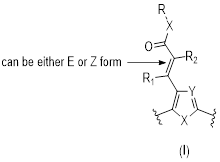Background
Organic electronics can be manufactured at lower costs as compared to conventional silicon-based electronics and are suitable for widespread applications including displays, radio-frequency identification (RFID) tags, chemo-/biosensors, memory devices, solar cells, photodiodes, etc. In addition, organic semiconductors can be processed at low temperatures and deposited on plastic substrates to enable light weight, flexible, and ultra-thin electronic devices. For solar cell applications, in particular, the cost of the polymer donor semiconductor materials is critical for the wide spread application of polymer solar cells. Although a number of polymer donors have achieved high power conversion efficiencies (PCE) over 10%, the synthesis of those polymer involves numerous steps and have high synthetic complexity (SC), which would results in high costs of the polymer solar cells.
Description of the invention
Waterloo researchers have developed novel semiconducting polymer compounds comprising a thiophene or other five-membered heteraromatic unit such as furan and selenophene that is substituted with an acrylyl or acrylyl-like (-C=C-CO-) side chain, which can be used as high performance polymer semiconductors for organic solar cells or organic photovoltaics (OPVs) and other devices including organic thin film transistors (OTFTs) and sensors. The above novel type of polymer semiconductor materials can be manufactured at much lower cost than, and perform similarly top the benchmark materials for solar cells.
Advantages
The complicated synthesis and thus high cost for the manufacturing of polymer semiconductors is a big barrier for the commercialization of organic solar cells. This technology was developed to offer an inexpensive polymer semiconductor for the mass production of organic solar cells. The reported UW Polymer Semiconductor Material have much fewer steps of synthesis thus offering an inexpensive semiconductor solution.
Potential applications
These polymer semiconductor materials could be used in: organic field effect transistors (OFET), thin film transistors (TFT), integrated circuits (IC), logic circuits, capacitors, radio frequency identification (RFID) tags, devices or components, organic light emitting diodes (OLED), organic light emitting transistors (OLET), flat panel displays, backlights of displays, organic photovoltaic devices (OPV), organic solar cells (OSC), photodiodes, laser diodes, photoconductors, organic photodetectors (OPD), electrophotographic devices, organic memory devices, sensor, charge injection layers, charge transport layers, polymer light emitting diodes (PLEDs), Schottky diodes, antistatic films, polymer electrolyte membranes.

Reference
10167
Patent status
US Patent application # 63/102,296
was filed on June 8th 2020
Stage of development
Proven Prototype &
Ongoing Development
Contact
Scott Inwood
Director of Commercialization
Waterloo Commercialization Office
519-888-4567, ext. 33728
sinwood@uwaterloo.ca
uwaterloo.ca/research